climate control JEEP GRAND CHEROKEE 2012 Owner handbook (in English)
[x] Cancel search | Manufacturer: JEEP, Model Year: 2012, Model line: GRAND CHEROKEE, Model: JEEP GRAND CHEROKEE 2012Pages: 380, PDF Size: 3.21 MB
Page 210 of 380
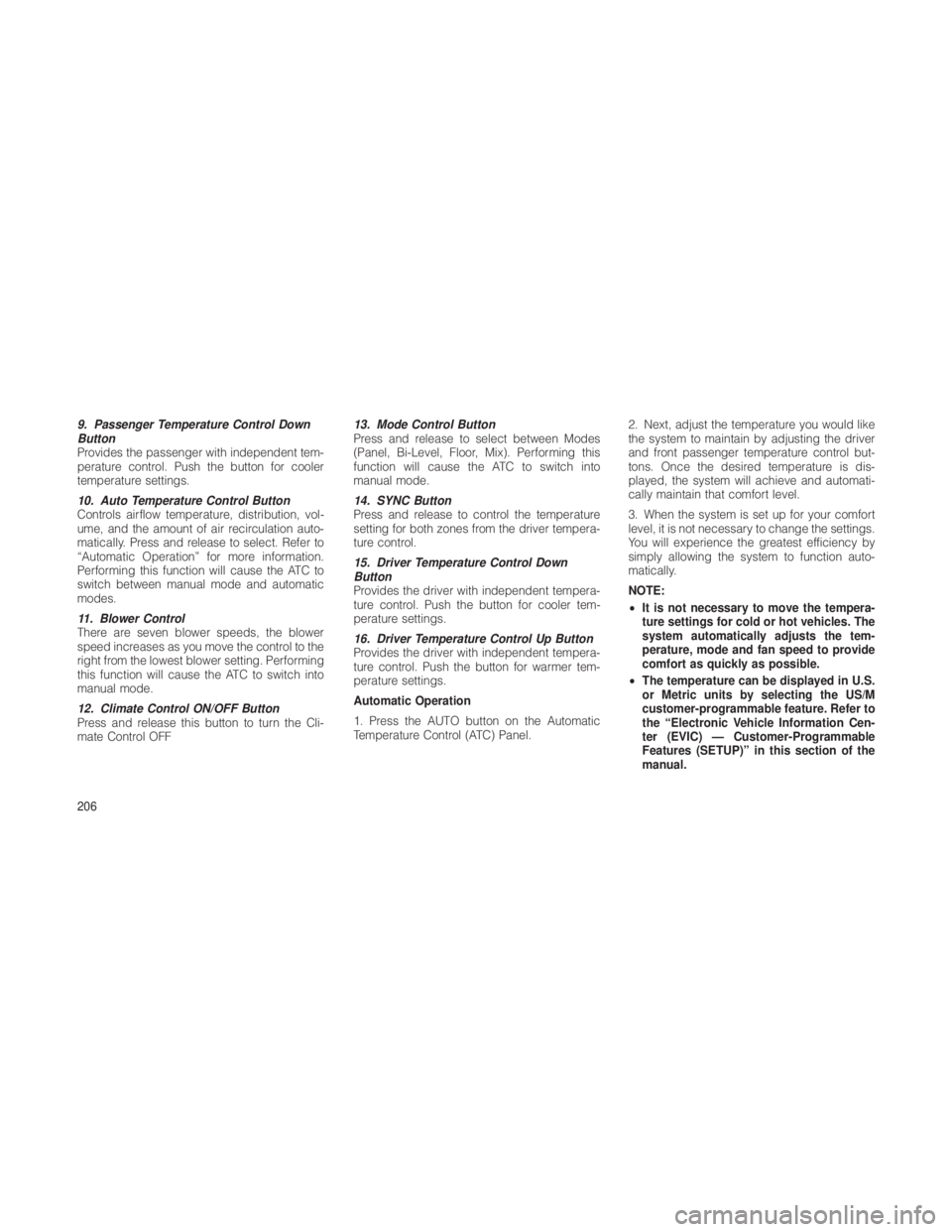
9. Passenger Temperature Control Down
Button
Provides the passenger with independent tem-
perature control. Push the button for cooler
temperature settings.
10. Auto Temperature Control Button
Controls airflow temperature, distribution, vol-
ume, and the amount of air recirculation auto-
matically. Press and release to select. Refer to
“Automatic Operation” for more information.
Performing this function will cause the ATC to
switch between manual mode and automatic
modes.
11. Blower Control
There are seven blower speeds, the blower
speed increases as you move the control to the
right from the lowest blower setting. Performing
this function will cause the ATC to switch into
manual mode.
12. Climate Control ON/OFF Button
Press and release this button to turn the Cli-
mate Control OFF13. Mode Control Button
Press and release to select between Modes
(Panel, Bi-Level, Floor, Mix). Performing this
function will cause the ATC to switch into
manual mode.
14. SYNC Button
Press and release to control the temperature
setting for both zones from the driver tempera-
ture control.
15. Driver Temperature Control Down
Button
Provides the driver with independent tempera-
ture control. Push the button for cooler tem-
perature settings.
16. Driver Temperature Control Up Button
Provides the driver with independent tempera-
ture control. Push the button for warmer tem-
perature settings.
Automatic Operation
1. Press the AUTO button on the Automatic
Temperature Control (ATC) Panel.
2. Next, adjust the temperature you would like
the system to maintain by adjusting the driver
and front passenger temperature control but-
tons. Once the desired temperature is dis-
played, the system will achieve and automati-
cally maintain that comfort level.
3. When the system is set up for your comfort
level, it is not necessary to change the settings.
You will experience the greatest efficiency by
simply allowing the system to function auto-
matically.
NOTE:
•
It is not necessary to move the tempera-
ture settings for cold or hot vehicles. The
system automatically adjusts the tem-
perature, mode and fan speed to provide
comfort as quickly as possible.
• The temperature can be displayed in U.S.
or Metric units by selecting the US/M
customer-programmable feature. Refer to
the “Electronic Vehicle Information Cen-
ter (EVIC) — Customer-Programmable
Features (SETUP)” in this section of the
manual.
206
Page 286 of 380
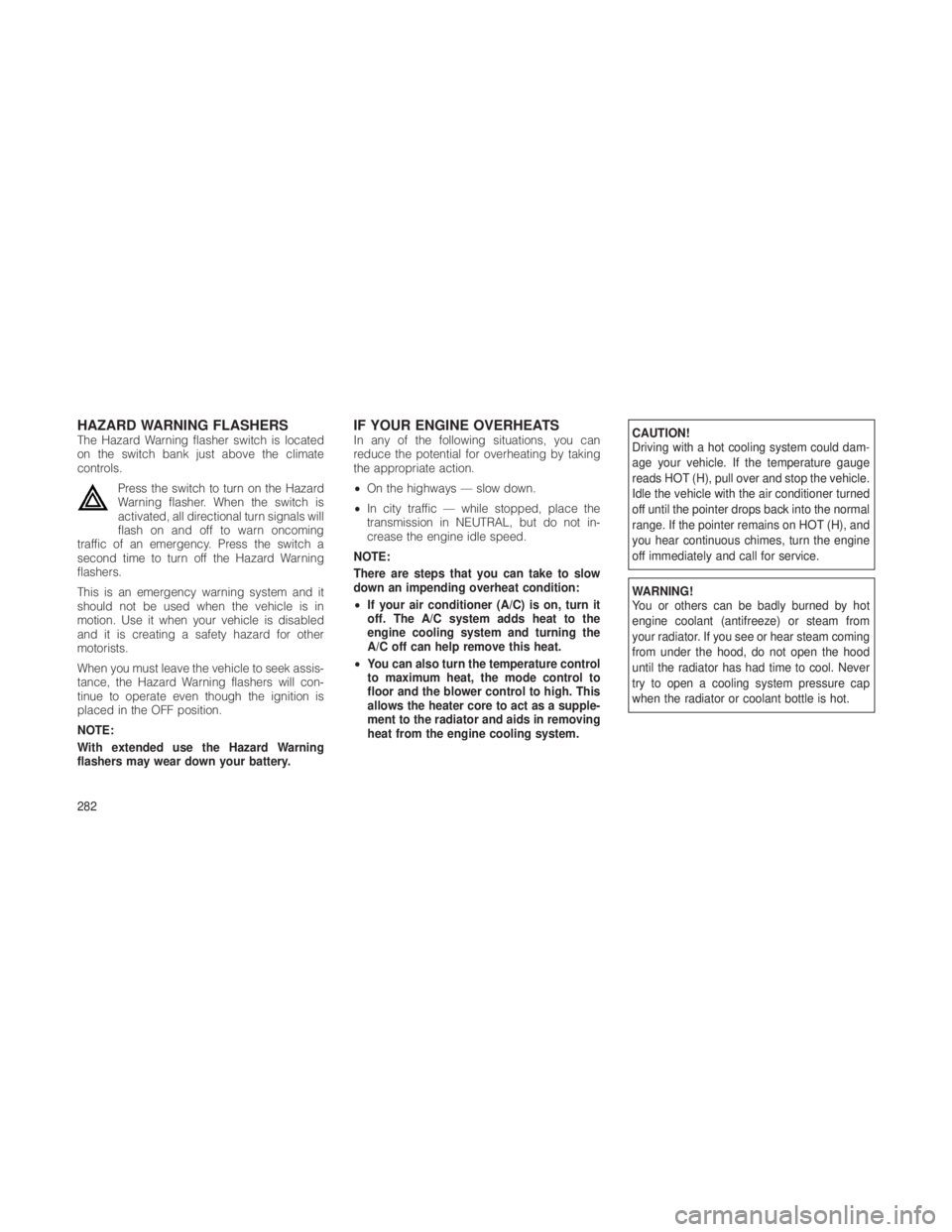
HAZARD WARNING FLASHERSThe Hazard Warning flasher switch is located
on the switch bank just above the climate
controls.Press the switch to turn on the Hazard
Warning flasher. When the switch is
activated, all directional turn signals will
flash on and off to warn oncoming
traffic of an emergency. Press the switch a
second time to turn off the Hazard Warning
flashers.
This is an emergency warning system and it
should not be used when the vehicle is in
motion. Use it when your vehicle is disabled
and it is creating a safety hazard for other
motorists.
When you must leave the vehicle to seek assis-
tance, the Hazard Warning flashers will con-
tinue to operate even though the ignition is
placed in the OFF position.
NOTE:
With extended use the Hazard Warning
flashers may wear down your battery.IF YOUR ENGINE OVERHEATSIn any of the following situations, you can
reduce the potential for overheating by taking
the appropriate action.
• On the highways — slow down.
• In city traffic — while stopped, place the
transmission in NEUTRAL, but do not in-
crease the engine idle speed.
NOTE:
There are steps that you can take to slow
down an impending overheat condition:
• If your air conditioner (A/C) is on, turn it
off. The A/C system adds heat to the
engine cooling system and turning the
A/C off can help remove this heat.
• You can also turn the temperature control
to maximum heat, the mode control to
floor and the blower control to high. This
allows the heater core to act as a supple-
ment to the radiator and aids in removing
heat from the engine cooling system.CAUTION!
Driving with a hot cooling system could dam-
age your vehicle. If the temperature gauge
reads HOT (H), pull over and stop the vehicle.
Idle the vehicle with the air conditioner turned
off until the pointer drops back into the normal
range. If the pointer remains on HOT (H), and
you hear continuous chimes, turn the engine
off immediately and call for service.
WARNING!
You or others can be badly burned by hot
engine coolant (antifreeze) or steam from
your radiator. If you see or hear steam coming
from under the hood, do not open the hood
until the radiator has had time to cool. Never
try to open a cooling system pressure cap
when the radiator or coolant bottle is hot.
282
Page 324 of 380
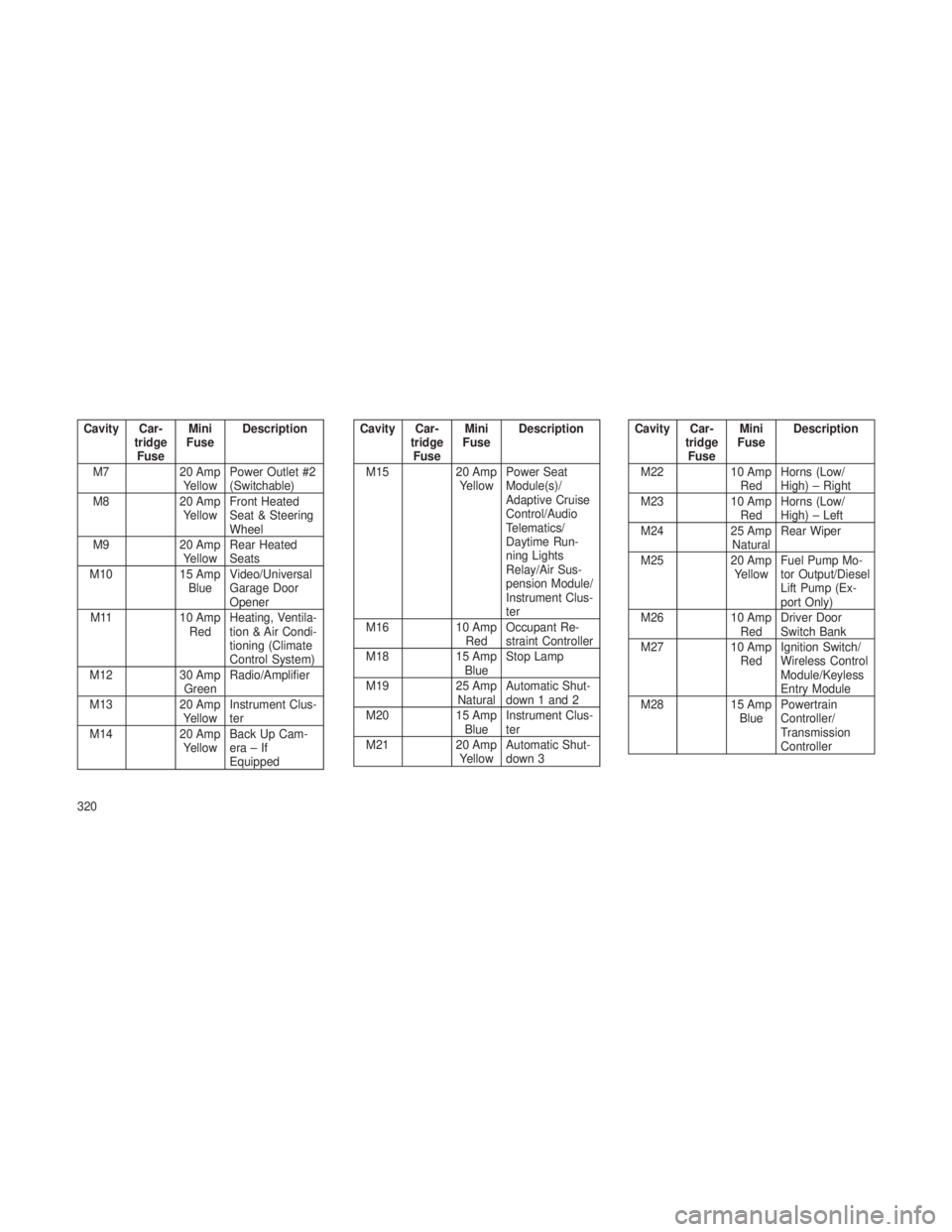
Cavity Car-tridgeFuse Mini
Fuse Description
M7 20 Amp YellowPower Outlet #2
(Switchable)
M8 20 Amp
Yellow Front Heated
Seat & Steering
Wheel
M9 20 Amp
Yellow Rear Heated
Seats
M10 15 Amp
Blue Video/Universal
Garage Door
Opener
M11 10 Amp
Red Heating, Ventila-
tion & Air Condi-
tioning (Climate
Control System)
M12 30 Amp
Green Radio/Amplifier
M13 20 Amp
Yellow Instrument Clus-
ter
M14 20 Amp
Yellow Back Up Cam-
era–If
EquippedCavity Car-
tridgeFuse Mini
Fuse Description
M15 20 Amp YellowPower Seat
Module(s)/
Adaptive Cruise
Control/Audio
Telematics/
Daytime Run-
ning Lights
Relay/Air Sus-
pension Module/
Instrument Clus-
ter
M16 10 Amp RedOccupant Re-
straint Controller
M18 15 Amp
Blue Stop Lamp
M19 25 Amp
Natural Automatic Shut-
down 1 and 2
M20 15 Amp BlueInstrument Clus-
ter
M21 20 Amp YellowAutomatic Shut-
down 3Cavity Car-
tridgeFuse Mini
Fuse Description
M22 10 Amp RedHorns (Low/
High) – Right
M23 10 Amp
Red Horns (Low/
High) – Left
M24 25 Amp
Natural Rear Wiper
M25 20 Amp
Yellow Fuel Pump Mo-
tor Output/Diesel
Lift Pump (Ex-
port Only)
M26 10 Amp
Red Driver Door
Switch Bank
M27 10 Amp RedIgnition Switch/
Wireless Control
Module/Keyless
Entry Module
M28 15 Amp
Blue Powertrain
Controller/
Transmission
Controller
320
Page 325 of 380
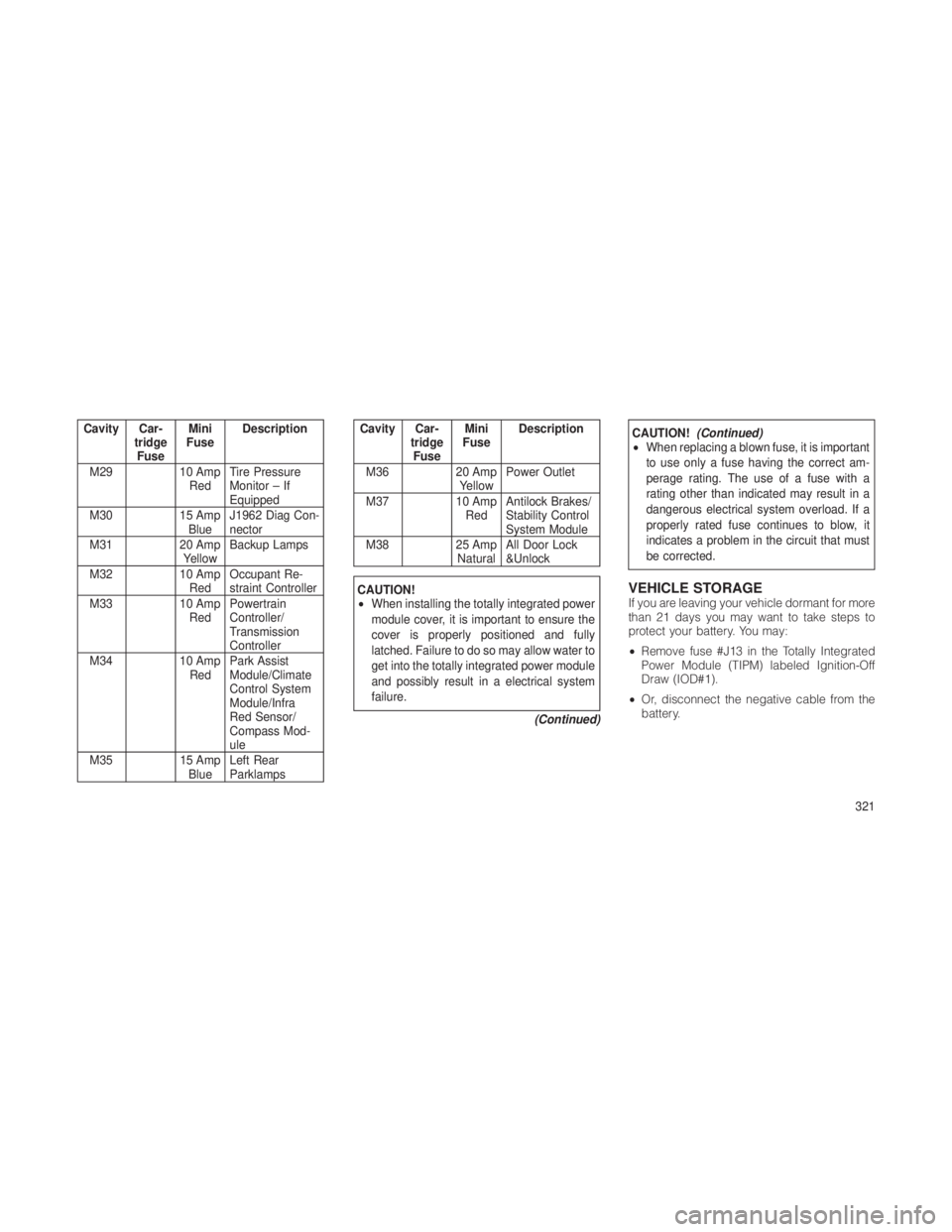
Cavity Car-tridgeFuse Mini
Fuse Description
M29 10 Amp RedTire Pressure
Monitor – If
Equipped
M30 15 Amp
Blue J1962 Diag Con-
nector
M31 20 Amp
Yellow Backup Lamps
M32 10 Amp
Red Occupant Re-
straint Controller
M33 10 Amp
Red Powertrain
Controller/
Transmission
Controller
M34 10 Amp
Red Park Assist
Module/Climate
Control System
Module/Infra
Red Sensor/
Compass Mod-
ule
M35 15 Amp
Blue Left Rear
ParklampsCavity Car-
tridgeFuse Mini
Fuse Description
M36 20 Amp YellowPower Outlet
M37 10 Amp RedAntilock Brakes/
Stability Control
System Module
M38 25 Amp
Natural All Door Lock
&Unlock
CAUTION!
•
When installing the totally integrated power
module cover, it is important to ensure the
cover is properly positioned and fully
latched. Failure to do so may allow water to
get into the totally integrated power module
and possibly result in a electrical system
failure.
(Continued)
CAUTION!(Continued)
• When replacing a blown fuse, it is important
to use only a fuse having the correct am-
perage rating. The use of a fuse with a
rating other than indicated may result in a
dangerous electrical system overload. If a
properly rated fuse continues to blow, it
indicates a problem in the circuit that must
be corrected.
VEHICLE STORAGEIf you are leaving your vehicle dormant for more
than 21 days you may want to take steps to
protect your battery. You may:
•Remove fuse #J13 in the Totally Integrated
Power Module (TIPM) labeled Ignition-Off
Draw (IOD#1).
• Or, disconnect the negative cable from the
battery.
321
Page 371 of 380
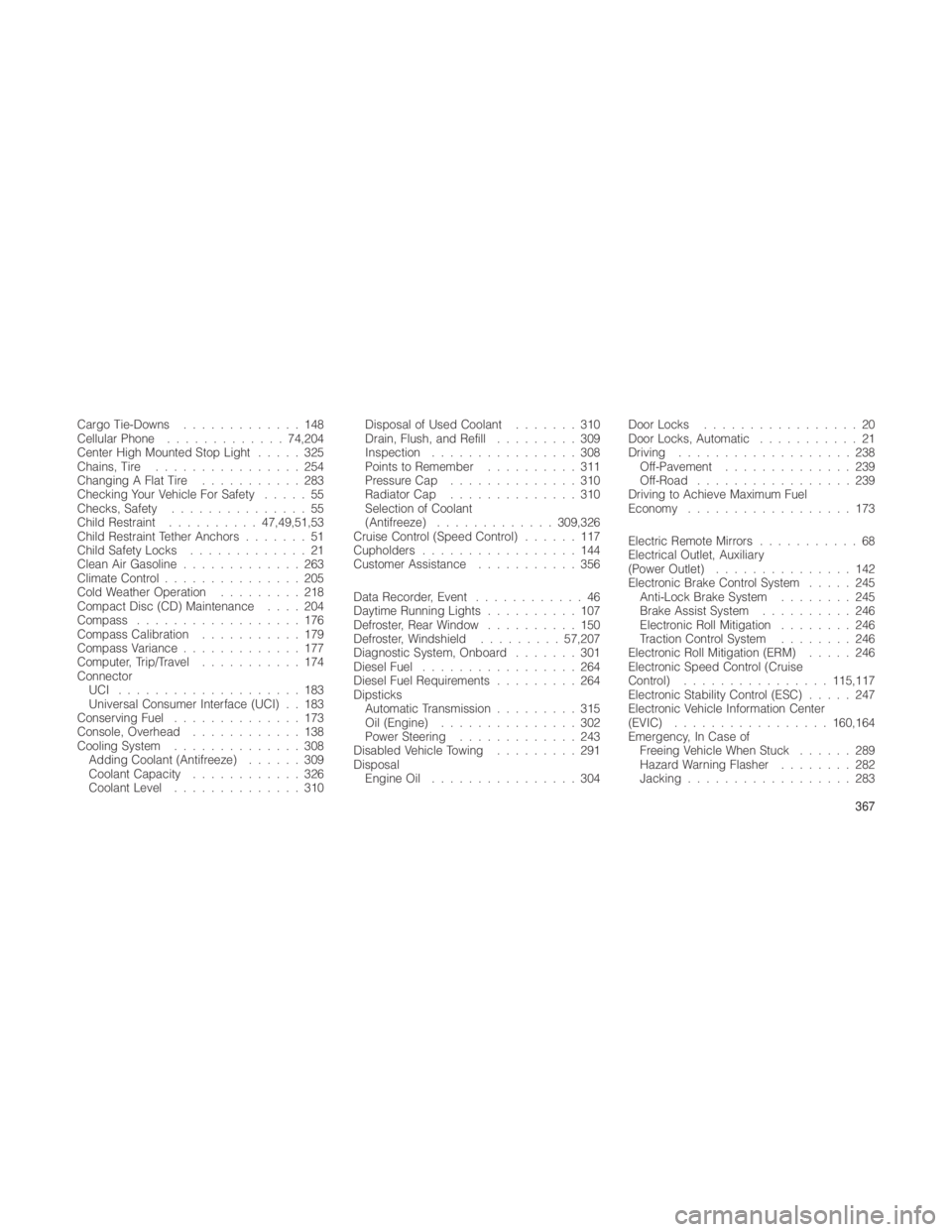
Cargo Tie-Downs.............148
Cellular Phone ............. 74,204
Center High Mounted Stop Light .....325
Chains, Tire ................254
Changing A Flat Tire ...........283
Checking Your Vehicle For Safety .....55
Checks, Safety ...............55
Child Restraint .......... 47,49,51,53
Child Restraint Tether Anchors .......51
Child Safety Locks .............21
Clean Air Gasoline .............263
Climate Control ...............205
Cold Weather Operation .........218
Compact Disc (CD) Maintenance ....204
Compass ..................176
Compass Calibration ...........179
Compass Variance .............177
Computer, Trip/Travel ...........174
Connector UCI ....................183
Universal Consumer Interface (UCI) . . 183
Conserving Fuel ..............173
Console, Overhead ............138
Cooling System ..............308
Adding Coolant (Antifreeze) ......309
Coolant Capacity ............326
Coolant Level ..............310 Disposal of Used Coolant
.......310
Drain, Flush, and Refill .........309
Inspection ................308
Points to Remember ..........311
Pressure Cap ..............310
Radiator Cap ..............310
Selection of Coolant
(Antifreeze) ............. 309,326
Cruise Control (Speed Control) ......117
Cupholders .................144
Customer Assistance ...........356
Data Recorder, Event ............46
Daytime Running Lights ..........107
Defroster, Rear Window ..........150
Defroster, Windshield .........57,207
Diagnostic System, Onboard .......301
Diesel Fuel .................264
Diesel Fuel Requirements .........264
Dipsticks Automatic Transmission .........315
Oil (Engine) ...............302
Power Steering .............243
Disabled Vehicle Towing .........291
Disposal Engine Oil ................304 Door Locks
.................20
Door
Locks, Automatic ...........21
Driving ...................238
Off-Pavement ..............239
Off-Road .................239
Driving to Achieve Maximum Fuel
Economy ..................173
Electric Remote Mirrors ...........68
Electrical Outlet, Auxiliary
(Power Outlet) ...............142
Electronic Brake Control System .....245
Anti-Lock Brake System ........245
Brake Assist System ..........246
Electronic Roll Mitigation ........246
Traction Control System ........246
Electronic Roll Mitigation (ERM) .....246
Electronic Speed Control (Cruise
Control) ................ 115,117
Electronic Stability Control (ESC) .....247
Electronic Vehicle Information Center
(EVIC) ................. 160,164
Emergency, In Case of Freeing Vehicle When Stuck ......289
Hazard Warning Flasher ........282
Jacking ..................283
367